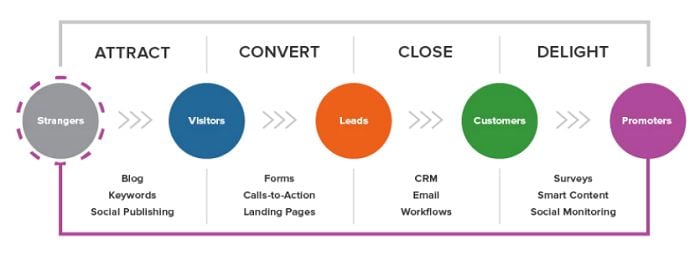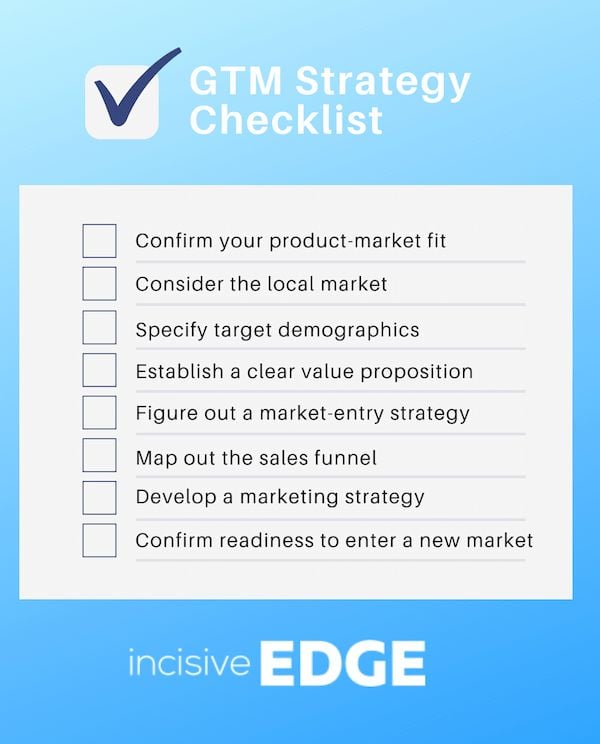
Thinking of launching a new product or service? Then having a solid go to marketing (GTM) strategy is vital for success.
It’s a stark fact. Most business launches fail. One researcher found that of the 30,000 products launched every year, 95 percent of them failed.
The odds don’t look good, do they?
Now, I won’t make you any promises. However, when you have the right GTM strategy, you are much better placed to connect with your target audience and make your launch a hit.
If you think that sounds like a dream come true, you’ll want to know where to start.
In this piece, I’ll detail how to craft an impeccable go to market strategy that sets you on the path to success.
Ready to learn more? Let’s get started.
What Is A Go To Market Strategy?
A go to marketing strategy details how a company will launch its product in a way that maximizes its potential for success.
It focuses on engaging customers to persuade them to buy while outshining competitors and covers pricing, marketing, and positioning tactics.
There are several components of a go to marketing strategy, including:
- Conducting market research that covers your target audience, competitors, and the potential market.
- Creating customer personas and mapping out the customer journey to understand your buyers better and reach them at the various touchpoints.
- Deciding on product positioning to determine how your product fits in the existing marketplace and what sets you apart. Typically that means setting out your value proposition to stand out from competitors.
- Creating a pricing strategy based on similar products. You’ll want to consider your costs, target audience, and business goals for this.
- Developing a sales and distribution plan. That means looking at how you’ll sell the product, market it, and fulfill orders.
- Drawing up a marketing plan. That may involve direct advertising, social media, PPC ads, and email marketing. Research shows marketers who proactively plan projects are 365 percent more likely to be successful.
Although the above pointers cover the basics of a GTM, there are multiple types of go to marketing strategies you could use. I’ll highlight some of these next.
Go To Market Strategy Types
The type of go to market strategy you’ll use depends on your company goals, the product you’re launching, and who you’re selling to.
For instance, if you were creating a GTM strategy for a SaaS company, you could use an online channel as part of your go to market strategy.
Here are some of the main types:
- Inbound marketing, where you’re using strategies like SEO, social media, blogging, pop-up forms, newsletter, and video marketing.

- Sales Enablement: This may be your preferred choice if you’re a startup business or face stiff competition. With this model, the sales team’s job is to position the brand/product and get prospects ready to buy.
- Account-based Marketing: With this go to market strategy, you target high-profile clients. An example here is businesses targeting high-value buyers rather than regular consumers.
- Demand Generation: If you want to create product demand, this is the strategy you’d choose. It uses outbound marketing techniques like cold calling, emailing, online ads, landing pages, and direct marketing.
- Direct Sales: Here, you’re selling products direct to consumers. You might do this if you target a niche market with high-margin products.
- Channel-led sales: With this approach, you partner with other companies, like agencies, resellers, and certified partners, to promote your products and services. You may choose this model if you target a large market with low-margin products.
- Freemium: This is where you offer an entry-level version of a product/service free, then charge for premium features or subscriptions.
- Online Sales: Do you sell your products and services purely online? Then you’d choose a digital marketing go to market strategy if you have a broad target market and you’re a high-profile online brand.
- Retail Sales: If you sell your products or services through brick-and-mortar stores.
- Strategic Partnerships: You might use this approach if you’ve got a narrow niche and you’re selling high-margin products, so you team up with other businesses to sell complementary products or services.
- Direct Mail: This type of go to market strategy is where you send marketing material to potential buyers.
The key to success is choosing a strategy that aligns with your business’s goals and ideal customers and then using a GTM strategy to launch it effectively.
To help you draw up your plan, you can get a free go to market template from Wrike.
Benefits of A Go To Market Strategy
Whether you’re a startup or an established business, having a clear GTM strategy can make all the difference in achieving your business goals.
Here are some of the benefits of an effective go to market strategy.
- A successful product launch: Defining your ideal audience and fine-tuning your messaging, sales channels, and pricing strategy as part of your go to market planning increases sales, improves brand awareness, and secures market share.
- Clear business direction: You can’t market your product effectively if you don’t have a plan. A go to market strategy ensures everyone in your company works in the same direction and understands their roles.
- Better use of your resources: When you have a go to market plan, you save time and money by reducing your risk of a failed launch and enabling efficient allocation of resources.
- Competitive advantage: Who doesn’t want to outcompete their rivals? A go to marketing plan ensures you’re well-positioned and differentiate yourself from your competitors.
- An improved customer experience: With a defined audience and clear messaging, you enable a consistent customer experience. That’s good news for your buyers. Why? Because your customer knows what to expect from all your different channels. That leads to improved customer satisfaction, loyalty, and retention.
- A quicker route to market. By having a GTM planning strategy in place, you can improve your speed to market by refining the positioning and messaging of your product and ensuring the logistics are in place.
How To Build Your Go To Market Strategy
A fantastic product or service isn’t anything without a solid go to market strategy behind it. In this section, I’ll provide some pointers to guide you as you prepare for your product launch.
- First, identify your target market: List the people most likely to buy your product or service. These are your core buyers. Ask yourself questions such as: Who are they? What do they do? Where do they live? How do they typically make purchasing decisions?
- Check if there’s a product fit, and understand the local market: Google’s free Market Finder tool allows you to identify operational information to know if your product is a good fit. You’ll also want to consider local regulations, licensing, and permits.
- Understand your value proposition: What makes your product or service different and better than others in the market? Clearly demonstrate the value you offer. Let’s say you were developing a new language app. In that case, you might write: “Our app uses cutting-edge technology and proven language-learning models to deliver personalized lessons suited to your learning style and pace.”
- Choose your channels: Will you create a strategic partnership, freemium, demand sales, or direct mail? Will you attend trade shows or conferences? Now’s the time to decide. Choose the channels to give you the greatest reach and impact among your target market.
- Develop your messaging: Once you’ve chosen your channels, you must develop your messaging for each. This means deciding on the language and tone you’ll use to communicate with your target market.
- Set up your goals and metrics: Unless you know what you want to achieve and what metrics to measure, you’re wasting your time. In marketing, we talk a lot about SMART (Specific, measurable, achievable, relevant, and Time-driven) goals, and with good reason. SMART goals enable you to focus your efforts and use your time effectively.
Also, refer to this checklist from Incisive-edge to ensure you’re ready to do business.

Best Practices For Go To Market Strategies
Going to market is challenging, and it doesn’t take much to knock even the most carefully laid plans off track. To help you navigate the uncertain road to your success, here are some go to market strategy best practices.
- Set deadlines and stick to them: Nothing creates a sense of urgency like an impending deadline. Set deadlines for each step of your go to market strategy and keep everyone on track with project management tools like Asana.
- Understand what’s possible: If you don’t have Coca-Cola’s marketing budget or distribution routes, then you’re not going to sell the millions of products that it sells every year. Consider your resources and figure out how far they can take you.
- Know who your audience is and understand them: Use customer avatars and customer maps to identify your ideal buyers, their preferred platforms, and any pain points along the way.
- Plan, plan, and plan some more: Think about things like product positioning, deciding on distribution channels, checking local laws, and having a customer services team in place to answer any questions.
- Define success: I’ve already mentioned this, but this step is worthy of a reminder. Choose the key performance indicators (KPIs) most important to your business. Whether it’s engagement, conversions, app installs, or cost per customer, defining your KPIs lets you see that you’re reaching your business goals.
- Monitor your KPIs: Keep a keen eye on your stats and adjust your go to market strategy if needed.
By now, with all the tips in this article, you should have developed a firm go to market strategy to launch successfully. However, if you need inspiration from companies that have gone before you, we’ll look at a couple of success stories next.
Go To Market Success Stories
Learning from others’ successes is an excellent way to find insights and inspiration for your go to market strategy.
Here, I’m sharing two stories from Slack and Fitbit Coach.
Slack

These days, Slack is one of the most popular messaging app platforms, and it’s a great alternative to getting caught up in long, complicated email chains.
As you can imagine, positioning itself as the alternative to email wasn’t the easiest of challenges.
It needed to develop an audacious campaign to position itself as a team communication tool that eliminates the need for emails.
The answer?
Slack labeled itself “the email killer” and set about selling itself as a simple-to-use communication solution that keeps things fun.
In other words, it sold the innovation rather than the solution. It wasn’t selling an email alternative. It was selling the ability to:
- Make effective decisions more efficiently.
- Reduce emails by 75 percent.
- Take “all your team communication, instantly searchable, available wherever you go.”
Slack’s positioning certainly captured consumers’ imaginations, going from 0 to 1 billion dollars in just eight months.
Not everyone can emulate Slack’s success. However, if you decide on a GTM strategy for your SaaS business, let stories like these inspire you.
Fitbit Smart Coach
Hands up, who hasn’t heard of Fitbit? Not many of you, I suspect.
It’s dominated the wearables industry for years, and a while ago, it announced a subscription service called Smart Coach.
As the Product Company explains, the GTM strategy behind it was pretty basic:
- Getting more subscription revenues
- Developing brand awareness
- Enhancing subscription attach rates (the percentage of consumers who buy additional products to their subscriptions).
It launched the “Get More With Fitbit” campaign using:
- Retargeting
- Paid ads and owned media (Online channels your brand controls, like social media or your website).
- Push notifications
- Social media
- newsletters
Fitbit’s go to market strategy was a massive success; Within six months of the launch, it had 500,000 subscribers.
The end result? The company earned an estimated $192 million in revenue through its strategy. Not bad at all.
FAQs
A go to market strategy defines how a business introduces or sells a product or service to consumers. It’s vital to success because it ensures you’re marketing to the right audience with the right messaging.
Creating a go to market plan requires a combination of research, analysis, and company teamwork. You also need to understand your target market, decide what messaging most likely resonates with them, and then find the best channels to market to them directly.
First, your need an understanding of your target market. You’ll need to team that with a clear marketing strategy and ways to measure and optimize product performance as you go.
A go to market strategy helps you to reach a new market effectively. When a company does the research and analysis before launch, it knows how to position itself to a fresh audience and helps avoid costly mistakes.
It also means you can address potential issues before launching, like local distribution routes, laws, or political issues that may impact trade regulations.
Failing to identify potential pitfalls of a new market, not creating clear messaging, and lacking a well-defined marketing strategy are all common challenges businesses face using go to market planning.
A company would need to define its ideas of success first. Then, the metrics a business would measure depend on its goals. Sales revenue, customer lifetime value, and customer acquisition costs are some metrics to focus on.
Digital marketing offers enormous potential for companies wanting to reach a new audience. It’s cost-effective, and by using methods like social media, PPC advertising, and email marketing as part of your online marketing plan, you can get a business in front of its target audience and increase conversions.
Conclusion
Business success relies on a lot more than pure good luck. Ask any mega-successful global brand, and they’ll tell you there was a product marketing strategy behind it.
While you need to figure out how to keep your audience engaged and the sales coming in post-launch, that shouldn’t necessarily be your starting point.
Before launching your business, you need a go to marketing strategy. That way, you can limit your chances of a launch failure.
As you develop your go to market plan, consider positioning your product, showing off your unique sales proposition, and being clear on your messaging. Additionally, you need to choose your channels and measure your metrics to ensure you’re on course for success.
Go to market planning also gives you a quicker, clearer route to your product launch, and who wouldn’t want that?
Do you use a go to market strategy? How does it help your business?
[ad_2]
Article link
